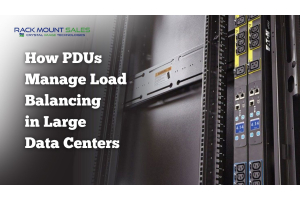The Future of Rackmount Monitors: Trends and Innovations
As technology continues to evolve, the need for reliable and efficient monitoring solutions has become increasingly important. Rackmount monitors are designed to offer users a space-saving and practical display option, and their popularity has grown significantly in recent years.
Definition of Rackmount Monitors
Rackmount monitors are display devices that are designed to fit into a standard 19-inch rack enclosure. They are commonly seen in server rooms, data centers, and other places where space is limited. A rackmount monitor's key advantage is its compact design, enabling users to monitor several servers or systems from a single place. Most monitors are also built to last, with features like anti-glare screens, reinforced frames, and premium parts.
Current State of Rackmount Monitors
At present, the market for rackmount monitors is relatively mature, with several established players offering a range of products to suit different needs and budgets. Some of the key features that users typically look for in a rackmount monitor include high resolution, fast response times, and wide viewing angles.
Trends and Innovations in Rackmount Monitors
Looking ahead, there are several trends and innovations that are likely to shape the future of monitors. One of the most significant is the increasing demand for higher resolutions and pixel densities. As more and more applications require detailed visual information, users are looking for monitors that can display images with greater clarity and precision.
Another important trend is the integration of advanced technologies such as AI, VR, and AR into rackmount monitors. These technologies have the potential to transform the way that users interact with their systems, providing new insights and capabilities that were previously unavailable. User-centered design is also becoming increasingly important in the development of monitors.
Future of Rackmount Monitors: Predictions and Forecasts
Based on these trends and innovations, it is clear that the future of rackmount monitors is likely to be shaped by a combination of technological advancements and user-centered design. Some predictions and forecasts for the future of rackmount monitors include:
- Increasing adoption of high-resolution displays, with 4K and even 8K resolutions becoming more common.
- Greater integration of AI, VR, and AR technologies into rackmount monitors, providing users with new insights and capabilities.
- Continued growth in demand for rackmount monitors, driven by the increasing importance of data centers and other IT infrastructure.
Implications for Industry and Consumers
The trends and innovations discussed above have significant implications for both industry and consumers. For manufacturers, the challenge will be to keep pace with rapidly evolving technologies and changing user needs, while also maintaining a focus on quality and reliability. There will be opportunities for new entrants to enter the market and disrupt established players, as well as for existing manufacturers to expand their offerings and stay ahead of the curve.
The repercussions for consumers are more immediate. As rackmount monitors become increasingly complex and intelligent, users will be able to do more with their systems, monitor and manage their data more effectively, and increase the overall performance and dependability of their infrastructure. However, consumers must be willing to make investments in these advanced technologies, as they are likely to cost more than ordinary displays.
Challenges and Opportunities for Rackmount Monitor Manufacturers
The future of rackmount monitors presents both challenges and opportunities for manufacturers. One of the key challenges for manufacturers will be to balance the demands of technological innovation with the need for reliability and durability. Rackmount monitors are often used in mission-critical applications, where downtime can be costly and disruptive. Manufacturers will need to ensure that their products are robust and dependable, while also incorporating the latest technologies to meet user needs.
Another challenge will be to manage the cost of developing and producing advanced rackmount observers. Manufacturers will need to precisely balance the benefits of advanced features and designs against the costs of products, in order to ensure that their products remain competitive in the request.
Manufacturers, on the other hand, can separate themselves from their competition by furnishing unique features and designs that fit the changing requirements of people.
The History of Rackmount Monitors: Evolution and Milestones
Rackmount monitors have a long and storied history, dating back to the early days of computing. The first rackmount monitors were simple cathode-ray tube (CRT) displays that were designed to fit into standard 19-inch server racks. These early monitors were often bulky and difficult to use, but they were an essential component of many early computer systems. Today's rackmount monitors are often equipped with high-definition displays, touchscreens, and other advanced features that make them more user-friendly and versatile than ever before.
Key Features and Benefits of Rackmount Monitors
Rackmount monitors offer a range of key features and benefits that make them an essential component of many modern computing systems. One of the key advantages of rackmount monitors is their compact size and form factor, which allows them to be easily integrated into standard server racks. This can help to reduce clutter and simplify cable management, while also freeing up valuable space in data centers and other computing environments.
Another key feature of rackmount monitors is their high level of durability and reliability. Many rackmount monitors are designed to withstand harsh environments, including temperature extremes, moisture, and vibration. This makes them well-suited for use in mission-critical applications where downtime can be costly and disruptive.
Market Analysis: Demand, Supply, and Competitive Landscape
The market for rackmount monitors is complex and highly competitive, with a range of manufacturers vying for market share. A multitude of factors, including the increased need for high-quality image and video display in data center and server environments, have boosted demand for monitors in recent years.
The market's supply side is also dynamic, with manufacturers constantly inventing new products and features to match changing user needs. At the same time, the competitive landscape for monitors is becoming increasingly crowded. While major companies continue to dominate the market, new entrants with unique products and features are also entering the area. This is anticipated to lead to more competition and further market innovation in the coming years.
Conclusion
In conclusion, the future of rackmount monitors is likely to be shaped by a combination of technological advancements and user-centered design. As more and more applications require detailed visual information, users are looking for monitors that can display images with greater clarity and precision. Producers will need to stay up with shifting needs by introducing new technology and features into their goods while still focusing on quality and dependability.
Overall, the future of rackmount monitors presents both challenges and opportunities for manufacturers and consumers alike. Companies can stay ahead of the curve and fulfill evolving user expectations with the correct strategy, while customers may benefit from increasingly modern and sophisticated monitoring systems that increase the performance and dependability of their infrastructure.











